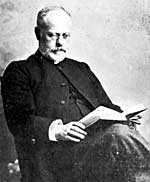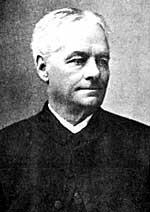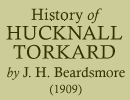< Previous | Contents | Next >
CHURCH INCOME AND PROPERTY.
In A.D. 1535 the Vicar's nett income was valued at £419s. 8d. This sum was made up of house (built at South and West street corner, of stone, and thatched), six acres of land, tithes of milk, sucking calves, horses, lambs, wool, hens, pigs, flax, hemp, and the fulling mill. This suggests that bee-keeping was common here in Henry the Eighth's time, and that the spinning-wheel was in common use. The fulling mill was near the site of the Great Northern Station. Tenter Ley is now called Millott's Yard; here were the tenter frames and hooks on which the cloth was stretched to dry. Tenter Hill, which was also probably used by the cloth fullers, is now occupied by Duke Street and school and other buildings.
This old water mill was fed by the Town Brook, and was latterly used for grinding corn. It was pulled down about 35 years ago.
A.D. 1654.—The Parliamentary Survey states that the income then was £45 per annum.
The Rev. J. E. Phillips, 20 years ago, showed the writer a Terrier which had been sent to him from a distant part of the country. The original document was lent to somebody by Mr. Phillips, and was never returned. The following is a copy of the Terrier:—
Nott., J.S.—A Terrier of the Gledbe land and houses belonging to
the Vicaridge of Hucknall Torkerd, September 17th, An. Dom. 1684.
Impris.—A dwellinghouse, two bayes and an outshoote, lately added
to it. In the possession of Henry Henson.
It[em].—One Barne consisting of one Bay. It.—One other Bay
new built.
It.—One close called Muckinfield close, containing by estimation
3 acres, in the possession of Henson.
It.—A Lay called Tenter Ley, lying by the Croft Ends, butting on
Shaw Lane end, and on the end of Willie Peacock's Hades (headlands).
One acre in North Hill field, abutting on the North on the Parson's Hadeland
of Linby; on the South on the Hadeland belonging to Edward Strans, bounded
by Mr. Sissons on the West, and by Mr. Curtice on the Easte.
It.—The Vicar's Close ffour acres at ye bottom of the Towne.
It.—At Tenter Hill three acres of arable land, abutting on Seggey
ficke south, on the Croft ends north, on the west of Thomas Butler (A),
on the east on Richard Clarkeston.
It.—One half-acre abutting on Seggficke south; and John Allen's
close North; upon Short Butts East; Robert Wayne lyeth West (B).
Witnesse our hands,
JOHN WALKER, THOMAS SISSON, SAMUEL ALLCOCK, RICHARD CLARKSON.
In A.D. 1765, the Governors of Queen Anne's Bounty granted £200 to the living, which was very poor, the parsonage being unfit for habitation, and the Vicar (Rev. T. Nixon) lived at Nuttall, and held that rectory, in addition to the Vicarage of Hucknall. £200 more was voted in A.D. 1792. In A.D. 1812 the sum of £200 was received from a Parliamentary Grant "for the augmentation of the Vicarage"—
The following extracts are from Terriers written in one of the registers kept in the Church Safe:—
"This is all in the same terrier."
"A copy of the Terrier of all the Glebe land, houses, orchards, tythes, stipendiary payments and all other ecclesiastical dues and profits whatsoever belonging to the Vicarage of Hucknall Torkard, delivered in at the primary Visitation of the Most Reverend Father in God, Robert, by Divine Providence Archbishop of York, held at Nottingham April 30th, 1764."
"A house, barn, and stable, all built with stone, and covered with thatch. One land in the South Field about 2 roods; another piece 11/2 roods, abutting on "Shea Lane"; 1 acre in the North Field; one pasture called "Muckenfield," 3 acres; a meadow of 4 acres; a close lately enclosed out of the South Field (Watnall Road district), 3 acres; a pension from the Crown, being £1 13s. 4d.
Great Tythes are enjoined to the estate of Lord Byron. Mortuaries are paid according to statute. "Farmers pay 6d. and cottagers pay 3d. per annum, and all other housekeepers or householders whatsoever 3d. per annum."
COMMUNION PLATE.
A pewter flagon; a pewter plate; a silver-gilt plate and cup with inscription: "This plate was given to the Church of Hucknall Torkerd by the Honble. Elizabeth Byron, daughter of the Right Honble. Viscount Chaworth, anno. 1664." "This cup was given to the Church of Hucknall Torkerd by the Honble. Elizabeth Byron, anno. 1664."
There are three bells and one clock.
Thomas Nixon, Vicar of Hucknall Torkard. J. Curtis, Wm. Daws, John Truman, Samuel Wagstaff, parishioners Joseph Haslam, Henry Hankin, churchwardens."
The second Terrier, dated June 11th, 1777, was taken at the Visitation at Nottingham of William, Archbishop of York, after the enclosure of the Common. It recites the possession by the Church of a close called "Glebe Lands," 17 acres, 1 rood, and 21 perches; a field called the Tythes, 4 acres, 20 perches, both bordering on Annesley Road. Also a parcel of 66 acres, 1 rood, and 36 perches on the Common. The Terrier proceeds:—"These lands were given in exchange for the lands en the opposite page" (that is some of the lands specified in the 1764 Terrier) "and also for a satisfaction of Small Tythes of all sorts by an Act of Parliament made in the year 1769. This was the Hucknall Torkard Common Enclosure Act.
As regards the Communion Plate. The cup and paten given by Lady Byron are kept in the Church safe, but the pewter flagon and plate are missing, though the writer saw the plate in the year 1872; it measured 16 inched in diameter.
A clock was placed in the tower about A.D. 1749, with a dial plate on the eastern face. It was rudely constructed with stone weights, and the village framesmiths frequently repaired it, but about the year 1870 it was past repair. The Duke of Portland presented a new clock with four dial plates, in 1884, cost £340.
In A.D. 1831 the income was £100 per annum, and in A.D. 1851 it was £135.
In A.D. 1908 the "Diocesan Calendar" gives the annual income as £566. The large increase resulted from the munificent gift of £10,000 by Mr. H. B. Paget (one of the partners in the Hucknall Colliery Co.) in the year 1878, to provide clerical help in consequence of the influx of colliers. The income has also been augmented in recent years by the sale of coal underlying the glebe lands.
THE VICARS.
The following list has been compiled from various sources, but chiefly from manuscripts collated by James Torre in the 18th century, and now kept in York Cathedral Library:—
A.D. 1235—Elyas; patron of the living, Archbishop of York.
A.D. 1288.—Adam de Radeford; patrons, Priors and Brothers of Newstead.
A.D. 1297.—Thomas Torcard ; patrons, ditto.
A.D. 1324.—Brother Richard of Stapleford; patrons, ditto.
Brother Will of Lenton; patrons, ditto. A.D. 1369.—Brother Edmund of St. Andrew; patrons, ditto.
A.D. 1382.—Brother John of Warsop; patrons, ditto.
A.D. 1398.—Brother Robert Bawtre; patrons, ditto.
A.D. 1414.—Brother Robert of Chesterfield; patrons, ditto.
A.D. 1414.—Brother John of Sutton; patrons, ditto.
A.D. 1433.—Brother Thomas Crofton; patrons, ditto.
A.D. 1459.—Brother John Kirketon; patrons, ditto.
A.D. 1478.—Brother John Walkeryngham; patrons, ditto.
A.D. I486.—Brother Will Kyme; patrons, ditto.
A.D. 1511.—Brother John Cowper; patrons, ditto.
A.D. 1532.—Richard Robthorne, presbyter.
A.D. 1545.—Will Baxter, presbyter.
A.D. 1550.—Rad Smith, clerk; patron, King Edward VI.
A.D. 1555.—Egidius Darbishier; patron, Queen Mary.
A.D. 1572.—Edw. Holte, clerk; patron, Queen Elizabeth. Robert Grace, clerk.
A.D. 1584.—John Thorpe, clerk; patron, Georgy Chaworth, High Sheriff of Notts.
A.D. 1617.—Henry Barlow, clerk, M.A.; patron, John Byron, junr., mil.
A.D. 1626.—Matthew Moore, clerk; patron, ditto.
A.D. 1634.—Adam Hunte, clerk, M.A.; patron, ditto.
A.D. 1647 to 1648.—John Cantrell, minister and schoolmaster.
A.D. 1659.—Hy. Hatton, clerke, a preaching minister and Nonconformist.
A.D. 1665 to 1682.—Will Seddons, curate.
A.D. 1725.—Andrew Matthews.
A.D. 1730.—C. Franke.
A.D. 1741.—Thomas Carter.
A.D. 1758.—Thomas Nixon.
A.D. 1787.—Charles Nixon; patron, Duke of Devonshire.
A.D. 1837.—John Valentine Austin ; patron, Duke of Portland.
A.D. 1848.—Curtis Jackson, M.A.; patron, Duke of Portland.
A.D. 1862.—George Otter, M.A.; patron, ditto.
A.D. 1879.—John Edward Phillips, M.A.; patron, ditto.
A.D. 1904.—Edward Roberts, M.A.; patron, ditto.
A.D. 1907.—Thomas Gerrard Barber, M.A.; patron, ditto.
Thoroton says: "In 1582 the Rectory, with the patronage of the Vicarage was granted to Edward Downing and Peter Ashton, (A) gent., but the manor the same Queen" (Elizabeth) "gave to Michael Stanhope, Esquire (one of the grooms of the Privy Chamber), and Edward Stanhope, Doctor of Laws." Edward Stanhope was M.P. for Notts, in A.D. 1571. William Byron, Esquire, of Bulwell Wood Hall, was patron about the year 1670.
NOTES ABOUT THE VICARS.
Of the early Vicars, but little can be gleaned. One of the Newstead monks in A.D. 1267 was named Helias de Hucknale, (B).
Adam de Radeford (probably the Redford near Worksop) was ordained deacon at Nottingham A.D. 1268.
John de Sutton, who died in 1433, was a Newstead monk before he was created Vicar of Hucknall. In his will he gave "his soul to Almighty God and Saint Mary and All Saints, and his body to be buried in the Churchyard of Hokenell."
Egidius Darbishier, who was appointed in 1555, may have been an ancestor of the Darbyshires, who gave the name to Derbyshire Lane, but there is no evidence of this.
Edward Holte, appointed to Hucknall in 1572, was given Linby Rectory in 1575.
John Thorpe, vicar 1584-1617, may have belonged the same Hucknall family as John Thorpe, the registrar, in 1665.
Matthew Moore, vicar 1626-1634 was deprived of his office for some reason.
A report was issued in 1659, during the time of the Commonwealth, which read as follows:—
"The impropriate living of Hucknall Torkard was £45 per annum, now under sequestration for a delinquency" (non-compliance with an Order of Parliament "of Sir John Byron, knight, and the profites thereof are received for the service of the State. Henry Hatton, clerke, the nowe Vicar, douthe officiate the cure there and receyveth the profite of the vicariage for his sallary, being worth £13 5s. 8d., and is a preaching minster."
Will Seddons was in charge six years later, and he appears to have been Rector of Linby as well as Vicar of Hucknall. In the chancel north wall at Linby is a memorial tablet in Latin, of which the following free translation has been kindly given by the Vicar of Blidworth:—"Hard by this wall lies the body of William Sed-don, for many years minister of this church, who at the sight of the Anglican Church gasping for life, himself became breathless, and rendered up his life to God through Christ, on the 28th day of February, 1684, aged 50.
His mortal life, death came and took away, The pattern such lives leave no death can slay."
The reference on the tablet to the state of the Anglican Church was probably directed against the Romanising efforts of James II.
Andrew Matthews, vicar in 1725, was also Rector of Linby, and a Byron Charity trustee. He died in 1729.
The Rev. Charles Nixon, who succeeded his father as Vicar of Hucknall in 1787 was also Rector of Nuthall. He was vicar 50 years, and the annals of the Windmill Club record the fact that he preached the club anniversary sermon 49 years. The Nixon family lived at Papplewick Hall and Nuttall many years.
The Rev. Curtis Jackson, vicar 1848-1862, erected St. Mary's Parsonage near the National School, on a site given by the Duke of Portland, and in 1854 he helped in the establishment of the National School. On resigning the vicariate in 1862 he succeeded his father, the Rev. Luke Jackson, as chaplain at Newstead. It is a tradition to this day that he gave more than his stipend to the poor of the parish.
The Rev. George Otter was 61 years old in 1862, when he was made Vicar, having spent a good portion of his life in Tasmania as convict chaplain, and there entertained Sir John Franklin, the Arctic explorer. Mr. Otter was an observant and well-read man, and a good public reader. He was Vicar 17 years, and retired into private life in his 79th year, on one-third of the stipend as allowed by an Act of Parliament, passed shortly before he left Hucknall. In his vicariate the Parish Church and National School were enlarged, and the present Vicarage built. Glebe land now covered by George, James and Peveril Streets was sold, the proceeds being sent to the Ecclesiastical Commissioners who from the interest thereon increased their contributions to the Vicar's stipend.

Rev. J. E. Phillips.
The Rev. J. E. Phillips, M.A., came as curate in 1875, and was created vicar in 1879. During his vicariate church progress was continuous. Mr. Phillips had much to do with the following important works:—A.D. 1884, Coffee Tavern erected, cost £1,320; reredos erected and chancel wainscotted; several extensions of the National School buildings; A.D. 1888, Parish Church enlarged, cost £4,500; A.D. 1892, St. Peter's built, £670; St. John's parsonage built, £640; A.D. 1895, St. John's Chancel and organ erected, £950; A.D. 1902, St. Peter's schools built. On the resignation of Canon Pavey, Mr. Phillips was created Rural Dean of Mansfield, in compliance with the expressed wish of the clergy. To Mr. Phillips' memory the parishioners and friends placed a brass and pulpit in the church, and a granite cross on his grave. It is fitting here to record the names of the assistant clergy who have officiated in the parish. The Rev. Thos. Hurt, rector of Linby, and his son, W. T. Hurt, frequently officiated in the years about 1840. The Rev. John Wright assisted the Rev. Curtis Jackson; the Revs. Cranmer, Dixon, Phillips, Hicks, and Ellis helped the Rev. George Otter; the Revs. J. B. Hyde, J. E. Hopkins, C. Blanchard, A. Mays, A. Wheeler, J. W. Nesbitt, J. Robinson, T. Bingham, Pigott, W. R. Warburton, Ploughman, A. E. Clarke, W. H. Harding, J. T. Godfrey, and A. E. C. Blomefield assisted Mr. Phillips.
The Revs. J. W. Walton and W. E. Bradley were curates during the Rev. E. Roberts' Vicariate, and the Revs. S. G. O. Anderson, T. H. J. Eling, and Rees Jones are the present assistant clergy.
CHURCHWARDENS.
The following is as complete a list as can be compiled from the sources accessible to the author:—
A.D.
1640—Ben Brough, Thos. Clark.
1641—Thos. Butler, Richard Lee.
1665—Thos. Waine, Henry Greenfields.
1669—Geo. Stayning, Wm. Cowe.
1670—Thos. Butler, Thos Spray.
1671—Thos Hardstaff, Nicholas Crampton.
1672—John Kitching, John Berry.
1674—Richard Newton, Lancelot Butler.
1675—Wm. Artin, John Beardsley.
1676—Wm. Symsonne, Thos. Button.
1677—Thos. Sargant, Robert Cropper. 1678—John Butler, Robt. Barton.
-------Richard Gilman, Robt. Hutchinson.
1728—John Curtis and Thos. Millot.
1729—Samuel Fish and Lancelot Malin.
1730—Richard Hill and John Stone.
1731—John Sugar and George Hopewell.
1732—John Ball for John Trueman.
1733—John Bettison.
1734—Jonathan Shaw.
1749—Theophilus Allcock.
1758—Joseph Walker, Wm. Rhodes.
1764—Joseph Haslam, Hy. Hankin.
1765—William Ball, Robt. Caunt.
1771-1790—Alexander Shaw.
1783—Benjamin Walker, Alexander Shaw.
1791—William Daws.
1793-5—Henry Daws.
1796—Edward Allcock.
1797-1802—Thomas Oldham.
1802-1816—George Green.
1817-1819—William Starr.
1820—Thomas Starr.
1836-8—Henry Daws.
1839-1852—James Ball, Matthew Limb.
1853-1856—John Godber, Matthew Limb.
1862-1892—James Widdowson.
---------William Needham Ball.
1873—John Raynor, junr.
1874-1893-—John Raynor, senr.
1892-5—George Cartledge.
1897—John Collins.
1898 to present day—William Jacklin.
1905 to present day—Francis Winfield.

Canon Godber.
The history of Hucknall would be incomplete without at least a brief reference to Canon Godber, who was so generous a giver to the church. He was born at Whyburn Farm, which was held by his father under the Duke of Portland, and inherited considerable wealth when his father died, including a landed estate in this parish. In his boyhood he attended a school in St. James's Street, Nottingham, and proceeded to Pembroke College, Oxford, where he took his B.A. in 1858, and M.A. in 1861. He was an old Sunday school teacher, and after his ordination served in several places as curate, and then became a diocesan preacher. Among his last benefactions were gifts of £1,000 to the Sunday School, £1,500 to the Godber Memorial Church Hall and £2,500 to the organ and churchyard maintainance fund. The poor lost a friend when he died in July, 1906, aged 72.
< Previous | Contents | Next >
(A) Thomas Butler was churchwarden A.D. 1670.
(B) The last of the Wains died in Hucknall about the year 1875, in the cottage
at the foot of Woodstock Street, now occupied by Mr. R. S. Webster.
(A) Peter Ashton probably lived at Newstead, for in the church register, in
the year 1561, the entry occurs:—" Nicholas, the son of Mr. Ashton
of Newsteade, was buried the XXth day of December."
(B) Surtees Society, vol. 109.
